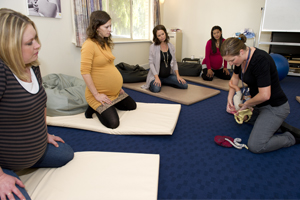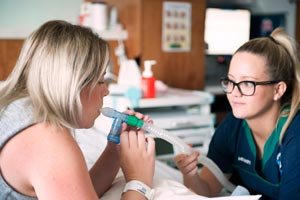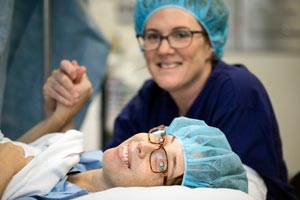Giving birth
 In Australia, overseas visitors, overseas students and patients who are not eligible for Medicare under their current VISA arrangements are required to pay for the cost of their health care. Please contact the Overseas Liaison Officer on (08) 6458 1066 or email KEMHPPLO@health.wa.gov.au to obtain information regarding fees for your appointment.
In Australia, overseas visitors, overseas students and patients who are not eligible for Medicare under their current VISA arrangements are required to pay for the cost of their health care. Please contact the Overseas Liaison Officer on (08) 6458 1066 or email KEMHPPLO@health.wa.gov.au to obtain information regarding fees for your appointment.
At around 30 weeks we encourage you to start thinking about your baby’s birth and your needs and expectations. This can help increase your confidence, to know what to expect and to prepare for the unexpected. Your midwife will talk to you about pain relief and answer any questions you have. Parent education classes can help a lot with your labour plans. They can help to reduce your fears and worries by giving you good information and building your knowledge about what is going on and what you may experience.
Bringing your belongings to hospital
There is limited storage space available for your belongings in hospital, please consider this when packing. Women and Newborn Health Service (WNHS) will not take any responsibility for the loss or theft of valuables, jewellery, monies and personal electronic devices. These items should be given to a relative or friend on admission to KEMH and in the event that you choose to retain them at your bedside then the hospital does not bear any responsibility in the event of a loss.
When labour begins
It can be difficult to tell when labour has started. If you are unsure and you are booked to have your baby at KEMH you can telephone the hospital. If there are strong signs of labour, such as your waters breaking, regular contractions or blood loss you should call KEMH or your midwife immediately, depending where you had planned to give birth.
Pain management in labour

Your experience of pain in labour can be influenced by a number of things like the environment in which you give birth, the support you receive, the position of your baby and the method of pain relief that you use. Find out your options for pain relief before your labour and make sure your midwife or doctor knows what you want. There are a number of natural and medical methods available for you to use in labour. Although some of the non-medical methods have not been subjected to rigorous research, you may find them helpful and they are unlikely to cause harm.
Options for pain management
Warm bath or shower
Available at: KEMH, FBC, CMP Some women find a warm bath or shower can help ease the pain of labour.
Gas (known as EntonoxTM)
Available at: KEMH, FBC The gas given to women in labour is a mixture of nitrous oxide and oxygen, sometimes known as ‘laughing gas’. Gas may reduce the intensity of pain during a contraction and is found to be helpful by some women. It is inhaled through a mask or a mouthpiece during a contraction. You may experience nausea, light headedness and a dry mouth for a short time and become drowsy with frequent use.
Epidural

Epidural can provide excellent pain relief. You will need to have an intravenous cannula and intravenous fluids running before the insertion of your epidural. It usually takes 10-20 minutes to set up and insert the epidural, and a further 5-10 minutes before it starts to work.
Monitoring your baby during labour
All babies will be monitored during labour by checking the baby’s heartbeat. The level of monitoring will depend on your medical history, whether there are any problems with your baby or whether there are any expected problems with the birth.
Water Birth
Water birth information sheet (PDF)
You may be considering using water for pain relief during the first stage of your labour or having a waterbirth.
Water immersion in a bath or a pool during the first stage of labour has been shown to decrease the need for pain relieving drugs and make the experience more enjoyable for women.
Waterbirths are associated with minimal risks for both the woman and baby when care is provided by midwives and/or doctors who follow best practice guidelines. Talk to your midwife if you would like to know more about water birth and the conditions for use.
For more information about pain options refer to our Pregnancy Birth and Your Baby Book (PDF).
Assisted birth options at WNHS

Assisted birth Forceps birth
Forceps are a special instrument placed around the baby’s head, inside the vagina to help guide the baby out. They may be used when the mother is too exhausted to push, the baby is in an awkward position or there are concerns for your baby’s wellbeing. Sometimes the forceps leave marks on the baby’s cheeks, but these soon fade. You will usually need an episiotomy.
Vacuum birth
This is more commonly used instead of forceps. The vacuum cup is made of either plastic or metal and is attached to a pump. The cup is inserted into the vagina and creates a vacuum against the baby’s head. This lets the doctor gently pull the baby out.
Episiotomy
This is a cut made in the perineum (tissue between the vagina and the anus). Sometimes it is necessary to make the vaginal opening bigger, especially if you need a forceps birth or if the baby is distressed. It is usually done with a local anaesthetic. You will need stitches afterwards. The stitches will dissolve by themselves and you will be offered ice packs to reduce swelling and pain.
Caesarean birth
A caesarean section is a major surgical operation in which your baby is born through a cut in your abdomen. It is usually performed under a spinal or epidural anaesthetic. Sometimes it is necessary to give a general anaesthetic to make you go to sleep.
After the birth of your baby

After the birth you will hopefully have the chance to spend some quiet moments cuddling and enjoying skin-to-skin contact with your baby. Parents are often filled with wonder when they meet their new baby and find themselves counting fingers and toes and examining their baby for family resemblances. Enjoy these special moments together as a family and take time to get to know each other.
If you are transferred to the postnatal ward this will usually be within 2 to 3 hours after the birth of your baby. You and your baby will stay together during your hospital stay. A midwife will care for you and will help you with looking after your baby. When you arrive in the ward the midwife will show you around and explain what you need to know.
Preparing to go home
When planning to go home from hospital it is a good idea to organise an extra support person to be with you for the first week. Talk to your partner and family about rearranging household tasks and making sure you find time to be together with the new baby. Your partner or support person can help with:
- Answering the phone/door
- Keeping visitors to a short stay
- Ensuring you get enough rest during the day
- Caring for other children and keeping their daily activities as normal as possible
- Preparing meals
- Shopping
- Housework
The Visiting Midwifery Service (VMS) is available to most women attending KEMH and the Family Birth Centre who reside within approximately a 40km radius from the hospital.
Overseas patient fees
Hospital fees for patients who are not eligible for Medicare are set by the WA Department of Health. Overseas visitors and overseas students are required to pay for the cost of their care. Calls made to the Maternal Fetal Assessment Unit (MFAU) by Medicare ineligible patients, such as overseas visitors and overseas students, will incur a charge.
More information about overseas patient fees.

